DPW Worker Run Over by Pickup Truck Exiting the Vehicle to Open an Overhead Garage Door
Michigan Case Report: 03MI025
Summary
On March 5, 2003, a 62-year old male Department of Public Works (DPW) employee was run over by a 3/4-ton pickup truck equipped with a snowplow that he had stopped and was exiting. He drove the truck to the front of an overhead garage door on a snow and ice covered, unsalted blacktop apron that extended 10-feet in front of the overhead garage door. He was exiting the truck to open the overhead garage door. An automatic garage door opener was located inside the pedestrian entrance door located adjacent to the overhead door. It appears that the victim thought he had placed the truck in Park; it is unknown if he applied the parking brake prior to exiting. It is unknown if he completely exited the truck when the truck began to move in reverse. Footprints in the snow indicated he used his right foot to try to re-enter the truck. There were no footprints of his left foot leading to the conjecture that his left foot was in the truck. According to the city police chief, his first footprint was approximately six yards from the overhead door and was repeated three times. He placed the front half of the right foot on the ground. The impression in the snow indicated his foot slid to the right and back. It appears that he lost his balance, fell, and was run over by the truck. He was rolled by the truck undercarriage then struck by the plow. The truck continued in reverse and struck the garage wall. People across the street noticed the truck at the side of the garage and went to investigate. Seeing the victim in the snow, one of the individuals contacted the police who called 911. Emergency response arrived and the victim was declared dead at a local hospital.
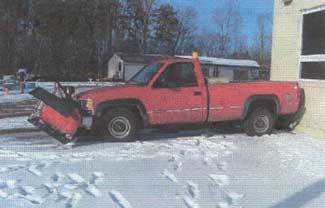
|
|
Figure 1. Final resting place of truck
|
Recommendations:
- Department of Public Works (DPW) standard operating procedures should address who and when snow/ice should be cleared from DPW pedestrian walkways and parking areas.
- The Department of Public Works should explore assigning each operator or equip each vehicle with a remote garage door opener for the overhead door.
- The Department of Public Works should develop a standard operating procedure for vehicle operations, including lowering any vehicle attachment to ground level prior to exiting, starting/stopping vehicles, etc.
- Employees should be instructed never to try to stop a moving vehicle.
Introduction
On March 5, 2003 a 66-year old male DPW worker was killed when he was run over by the truck he had stopped and was exiting. On March 19, 2003, MIFACE investigators received a newspaper clipping about this incident. On August 13, 2003 the MIFACE researcher visited the site, talked with the city manager, DPW supervisor and city police chief about this incident. During the course of writing the report, the death certificate, autopsy results, and police report were obtained. Figure 1 and Figure 5 are police photographs taken at the time of the incident, remaining figures in this report were photos taken at the time of the MIFACE site visit.
The DPW has four employees and has been established at least 20 years. This was their first fatality. The victim was a full-time, hourly worker. He typically did many jobs as an employee such as running heavy equipment, reading meters, running street sweepers, etc. He had fifteen years of work experience in the DPW. The DPW had a written safety and health plan, but no specific standard operating procedures for vehicle operation. There is no safety and health committee, but safety meetings are held with employees on an “as necessary” basis. All DPW employees have attended various education and training courses sponsored by the employer, municipal league and various trade unions. The victim’s usual work shift was 7:00 am to 3:30 pm, five days a week.
Back to Top
Investigation
All 3/4-ton pickup trucks used by the DPW have an automatic transmission and use diesel fuel. On the day of the incident, the victim’s shift started at 5:00 am due to a recent snowfall. He had been using the pickup to clear snow from the roadways. It was sunny and between 17o-20o F. He returned to the garage after plowing the snow and spoke with another employee. He left the garage and drove his truck to another location to read some water meters. This was the truck he normally drove. Daily truck inspections are performed to check oil level, brakes, etc. The DPW worker indicated that trucks are taken to a local mechanic if there are reported problems with the vehicle. The victim did not report any problems with the truck. The incident occurred upon his return from reading the meters at the end of his workday, approximately 3:30 pm.
The victim returned to the DPW garage to park the truck in the garage. The garage’s equipment entrance, a 16 -foot overhead door, is located on a north wall at the “rear” of the building. On the ground in front of the overhead door is an asphalt apron that extends 10-feet in front of the overhead door. The apron was snow and ice-covered and had not been salted. The lot behind and to the side of the garage was covered with a mixture of sand and gravel and had not been plowed or salted. The overhead door allowing vehicles to be driven into the garage was remotely controlled by a garage door opener mounted on the wall approximately 6-inches from the frame of the pedestrian door located adjacent to the overhead door. On the day of the incident, the pedestrian door was left unlocked; the victim did not need to remove his keys from the ignition to unlock the door. See Figures 2 and 3.
As the victim drove into the lot to proceed to the rear of the building to enter the garage, he waved to some friends at a business across the street. What took place when he reached the rear of the garage was unwitnessed. The following sequence of events has been developed with the assistance of the police report, interviews with fellow workers, and the police chief.
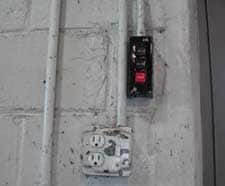
|
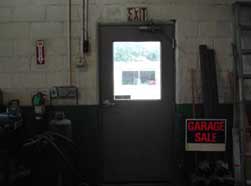 |
|
Figure 2. Remote garage door
opener by pedestrian door |
Figure 3. Remote control garage
door opener by pedestrian door |
During the MIFACE visit, a DPW worker positioned the truck to the location where the victim might have driven the truck to prior to exiting. (See Figure 4) The plow was raised approximately 10-inches from the ground. There is a slight incline at the entrance to the overhead door. The truck’s front wheels would have probably been turned at an angle as a result of making a circle to enter the overhead door and to position the truck so it could be parked. Vehicles were parked in the DPW garage at an angle. Figure 4 shows the truck orientation at the garage and location of the pedestrian door. Note that the front wheels are turned as a result of driving to this location through the back lot and positioning the truck to drive at an angle into the garage.
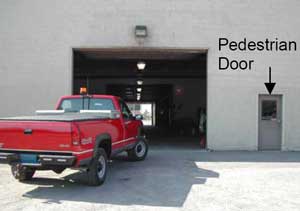
|
|
Figure 4. Possible location of truck when pulled onto asphalt apron
|
The victim may have thought he placed the truck gearshift in Park, but the truck may have been in either Neutral or Reverse. The truck began to move in reverse. It is unknown if the victim had completely exited the truck when it began to move in reverse and if he had applied the parking brake or if he was attempting to apply the parking brake located on the drivers left as he was reentering the vehicle. It appears he was trying to re-enter the truck to stop the reverse movement. The police chief stated that only his right foot left an impression in the snow; his right foot faced forward (toward the garage door). The first imprint was approximately six yards from the overhead door. Multiple right foot impressions in the snow are thought to be efforts he made to climb back into the truck, presumably to stop the truck. The imprints are repeated three times. He placed the front half of the right foot on the ground. The impression in the snow indicated his foot slid to the right and back. It appears that he lost his footing, fell, and was run over by the driver’s side front truck tire, rolled by the truck undercarriage, and then struck by the plow. The truck continued in reverse in a smooth, symmetrical, circular arc (approximately a 270-degree arc) from the point where the victim may have driven the truck onto the apron to the resting point at the northwest corner of the garage wall. Figure 5 shows the area behind the garage where the footprints were visible. The orange cones mark the path of the truck as it traveled in reverse before coming to rest against the west wall of the garage. The truck finally came to rest against the west wall, the truck cab facing to the west with its wheels spinning. (See Figure 1 )
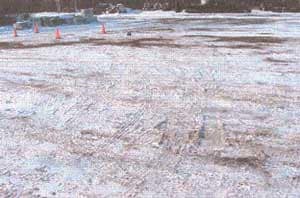
|
|
Figure 5. Area behind truck where victim tried to reenter truck
|
An individual at a business across the street saw the truck moving in reverse and come to rest at the west garage wall. When the truck did not move and its backup alarm continued to sound, the individual became concerned. He alerted other individuals and they went to investigate. When they arrived at the garage, the key was in the ignition and the gearshift was in reverse. The truck was running with the wheels spinning; the backup lights were on and the backup warning indicator was sounding. The windshield wipers were operating at high speed. They found the victim in the snow behind the garage in approximately the middle of the truck’s reverse arc. The police who shared the building were notified and they called 911. Emergency response arrived and transported him to a local hospital where he was declared dead.
Back to Top
Cause of Death
The cause of death as listed by the medical examiner on the death certificate was crush injury with brain contusion-laceration. Toxicological results were negative.
Recommendations/Discussion
Department of Public Works (DPW) standard operating procedures should address who and when snow/ice should be cleared from DPW pedestrian walkways and parking areas.
During the winter months, a priority concern for Department of Public Work departments can be clearing snow from city/county roads. Although clearing DPW parking lots may be assigned a low priority, the slippery surface of the asphalt/parking lot was a factor in this work-related death. There was an individual who had returned to the DPW garage prior to the victim arriving at the garage and then leaving to read the water meters. The first individual to arrive after clearing snow could be assigned the responsibility of clearing/salting the DPW pedestrian/parking areas.
The DPW should explore assigning each operator or equip each vehicle with a remote garage door opener for the overhead door.
The DPW had installed a remote control overhead door operating system near the pedestrian door to assist operators in opening and closing the overhead door. MIFACE recommends that the DPW explore the possibility of having a remote control garage door opener assigned to each operator or equip each vehicle that is driven and stored in the garage with a garage door opener. This would allow an operator to stay in the vehicle to open as well as close the overhead door when coming out of the garage if he/she is the only individual present. This would eliminate the need for the operator to exit the vehicle and provide for operator safety, not only in inclement weather but also at night.
The DPW should develop a standard operating procedure for vehicle operations, including lowering any vehicle attachment to ground level prior to exiting, stopping/parking vehicles, etc.
The DPW employees operate several types of vehicles during the course of their work operations. Although each vehicle may have similar operating characteristics, there will be differences due to the uniqueness of each vehicle. The SOP should include day-to-day vehicle operation procedures, such as vehicle inspection, smoking policy in the vehicle, parking procedures, item securement in the vehicle, etc. The SOP should determine the procedures a driver must follow when exiting a vehicle, such as lowering the attachment to the ground (if equipped), applying the parking brake (as necessary), etc. Signs could be placed on the vehicle’s dashboard as a reminder for drivers to place the plow down and apply the parking brake. Other elements of the vehicle operation SOP could include reference to Michigan driving laws, vehicle driver qualifications and training, and accident reporting and evaluation.
Standard operating procedures (SOPs) provide many benefits to an organization. Among the benefits are: removing variation in work performance caused by different people doing the same job, facilitate employee job training as well as cross-training, provide a common understanding of the job and expectations for job performance, help to provide a safe work environment by assessing hazards and risk and providing ways to minimize the identified hazards/risks, and when written collaboratively between management and workers, provides for employee involvement and buy-in of the scope and intent of the standard operating procedure.
If practical, SOP development and implementation should be a joint effort of the people who are directly affected by it. The scope of the SOP should be defined and named using descriptive words. An overall task description should be developed identifying equipment and supplies, number of people, Personal protective equipment required, etc. After the overall task description is developed, each task should be described in detail, keeping the number of steps to complete the task below ten. Implementing the SOP involves testing the SOP draft, communicating with employees about the SOP and training them in the SOP content. A system should be set up to monitor the implementation and use of the SOP to ensure its applicability and ease of use for the worker and operation.
Employees should be instructed never to try to stop a moving vehicle.
Operators should be instructed that they are not to attempt to remount a moving vehicle. Although the truck was moving at idle speed, his best safety action would have been to let the truck come to rest naturally instead of trying to get back into the cab to stop its movement. It should have been let go and retrieved once it came to rest.
Back to Top
References
- Grusenmeyer, David. Developing Effective Standard Operating Procedures, Sr. Extension Associate, PRO-DAIRY, Cornell University. Internet address: http://www.ansci.cornell.edu/pdfs/sopsdir.pdfpdf iconexternal icon (Link updated 3/31/2009)
There are no MIOSHA standards that apply to this incident, but if you would like copies of the standards, they can be directly accessed from the Consumer and Industry Services, MIOSHA web site http://www.michigan.gov/lara/0,4601,7-154-61256_11407_15368—,00.htmlexternal icon (Link updated 3/27/2013).
The Standards can also be obtained for a fee by writing to the following address: Department of Consumer and Industry Services, MIOSHA Standards Division, P.O. Box 30643, Lansing, MI 48909-8143. MIOSHA phone number is (517) 322-1845.
Michigan FACE Program
MIFACE (Michigan Fatality and Control Evaluation), Michigan State University (MSU) Occupational & Environmental Medicine, 117 West Fee Hall, East Lansing, Michigan 48824-1315. This information is for educational purposes only. This MIFACE report becomes public property upon publication and may be printed verbatim with credit to MSU. Reprinting cannot be used to endorse or advertise a commercial product or company. All rights reserved. MSU is an affirmative-action, equal opportunity employer. 11/20/03
MIFACE Investigation Report # 03MI025 Evaluation (see page 7 of report)
To contact Michigan State FACE program personnel regarding State-based FACE reports, please use information listed on the Contact Sheet on the NIOSH FACE web site Please contact In-house FACE program personnel regarding In-house FACE reports and to gain assistance when State-FACE program personnel cannot be reached.
